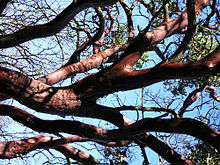- Manzanita
-
Manzanita is a common name for many species of the genus Arctostaphylos. They are evergreen shrubs or small trees present in the chaparral biome of western North America, where they occur from southern British Columbia, Washington to California, Arizona and New Mexico in the United States, and throughout much of northern and central Mexico. They are characterized by smooth, orange or red bark and stiff, twisting branches. There are 106 species of manzanita, 95 of which are found in the Mediterranean climate and colder mountainous regions of California, ranging from ground-hugging coastal and mountain species to small trees up to 20 feet (6m) tall. Manzanitas bloom in the winter to early spring and carry berries in spring and summer.[1] The berries and flowers of most species are edible.
The word manzanita is the Spanish diminutive of manzana (apple). A literal translation would be little apple. The name manzanita is also sometimes used to refer to species in the related genus Arbutus, which is known by that name in the Canadian area of the tree's range, but is more usually known as madroño, or madrone in the United States.
Contents
Uses
Culinary use
Traditional uses of the plant include collecting the berries, drying them, and grinding them up into a coarse meal. Fresh berries and branch tips were also soaked in water to make a refreshing cider. The younger leaves are sometimes plucked and chewed by hikers to deter thirst.[citation needed] Native Americans used Manzanita leaves as toothbrushes.[2][unreliable source?]
Landscape use
Manzanitas are extremely useful as ornamental plants in gardens in the western United States and similar climate zones. They are evergreen, highly drought-tolerant, have picturesque bark and attractive flowers and berries, and come in many sizes and growth patterns.
Arctostaphylos columbiana, for example, is hardy enough to be used for highway landscaping in western Oregon and Washington. A. uva-ursi (the Bearberry), and other low-growing manzanitas are extremely valuable evergreen groundcovers for dry slopes. Larger varieties, such as Arctostaphylos. 'Dr. Hurd,' can be grown as individual specimens, and pruned to emphasize the striking pattern and colors of the branches. They prefer light, well-drained soil, although the low-growing ground covers will tolerate heavier soils.
Decorative use
Manzanita branches are popular as decoration, due to their unique shape, color, and strength when dried.
The wood is notoriously hard to cure, mostly due to cracking against the grain, giving it few uses as timber. The slow growth rate and many branchings further decrease the sizes available. Some furniture and art employ whole round branches, which reduces cracking and preserves the deep red color.
The dead wood decays slowly and can last for many years, on and off the plant. Sunlight smooths and bleaches manzanita to light grey or white, rendering it superficially akin to animal bones. Because of this and the stunted growth of many species, manzanita is often collected in its more unusual shapes, giving it the nickname mountain driftwood.
Manzanita wood is also used as perches for parrots and other large pet birds. The branches of the larger species are extremely long-lasting for this purpose.Some aquarium keepers use sandblasted manzanita as driftwood in planted aquaria because of its attractive forked growth and its chemical neutrality.
If properly cleaned and cured, it holds up well over extended periods of submersion. The wood is also resistant to the leaching of tannins into the water column, a problem often found with other aquarium driftwoods. When used as driftwood, manzanita must often be either weighted down for several weeks or soaked first to counteract the wood's natural buoyancy.
Manzanita wood, when dry, is excellent for burning in a campfire, barbecue, fireplace, or stove. It is dense and burns at a high temperature for long periods. However, caution should be exercised, because the high temperatures can damage thin-walled barbecues, and even crack cast iron stoves or cause chimney fires.
Rarity and endemics
Some manzanita species are among the rarest plants in the world. The endemic Arctostaphylos hookeri ravenii (Presidio manzanita) is the most endangered and restricted plant in the mainland United States. In 1987 only one specimen remained, at a secret location in the Presidio of San Francisco National Historic Landmark District in San Francisco, California. This plant has since been successfully cloned.[3] Arctostaphylos franciscana (Franciscan Manzanita), a species native to San Francisco, had not been seen growing wild since 1947 until it was spotted growing in the Presidio of San Francisco in October, 2009.[1] Caltrans transplanted this specimen on January 23, 2010, to make way for the Doyle Drive Replacement Project.[4]
See also
- California sagebrush
- Chamise
- Coyote brush
- Bearberry
- Category: Arctostaphylos
References
- ^ a b http://www.sfgate.com/cgi-bin/article.cgi?f=/c/a/2009/12/26/BA0L1B57HP.DTL
- ^ Bear Grylls Man vs. Wild Sierra Nevada episode (US: 8 December 2006 Discovery Channel, UK: 31 Mar 2007 Channel 4)
- ^ 02.08.95 - Researching The Last Manzanita
- ^ Caltrans. (2010, January 23). Doyle Drive Transplanting Manzanita Bush 01-23-10. Retrieved March 11, 2010, from http://www.dot.ca.gov/dist4/photography/images/100123/
External links
- San Francisco Chronicle Story – Part 1 (May 2008) "Mysterious Manzanita Baffles Homeowners", by: Ron Sullivan, Joe Eaton, Wednesday, May 7, 2008. Of great interest note in Article that this is not Presidio manzanita but an as yet unclassified species!
- ITIS 23467 ITIS species list
- Manzanita in Central Arizona Good photo of the copper colored bark.
- SF Weekly cover story about the Manzanita (April 2008)
Categories:- Arctostaphylos
- Flora of North America
- Flora of the Western United States
- Flora of California
- Flora of Canada
- Flora of British Columbia
- Garden plants
- Medicinal plants
Wikimedia Foundation. 2010.



